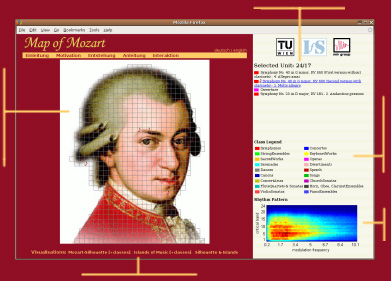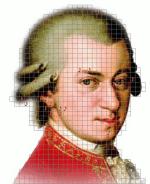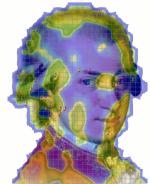| deutsch / english | |
| Introduction Motivation Creation Guide Online-Demo | |
How to explore the Map of Mozart
The Map of Mozart is divided into a grid of small squares. A number of music pieces has been assigned automatically to each square. Similar music is located on squares close to each other, while pieces with little musical similarities are located further away.
With intense concentration of similar music on whole regions, clusters or islands emerge, visible through the Islands of Music visualization.
As visualizations, the silhouette of Mozart, the Islands of Music and one hybrid-view (semi-transparent with both visualizations) are selectablel. Additionally, the (manually created) assignment to categories can be superimposed on the visualizations as pie charts.
The class legend shows an arrangement of the Map of Mozart in various, color-coded categories such as operas, symphonies, piano ensembles, divertimenti, etc. Thus, one can find, for example, the string ensembles (light green category) in the region of Mozart's right ear, while the dances (salmon colored category) are arranged left-above of the string ensembles in the region of the back of the head. The list of pieces of music, displayed on the right side, indicates the assignment to these categories via a colored bar.
| For each selected square, a list of titles of the assigned pieces of music
of Mozart appears. The colored bar indicates the category of the piece of music. A symbol of a note |
|||
| By clicking on single squares of the Map of Mozart you will get information on which pieces of music are located in this region of the map. By simply moving over a square of the map with the mouse, a pop-up text with the pieces of music assigned to this square will be displayed. |  |
||
| The class legend shows the assignment of colors used in the bars and the pie charts in the visualizations to the categories into which Mozart's music was manually divided. | |||
| The rhythm pattern window displays the underlying acoustic features of each square of the map graphically. | |||
|
Below the Map of Mozart you can switch between the different visualizations:
|
|||
Advanced functionality:
*The Map of Mozart turns into a real interactive experience if the music represented on the map can also be listened to. Due to copyright limitations we cannot offer the complete works of Mozart. For this reason, for the time being, only a few freely available pieces of music (Wikipedia, Internet Archive) can be listened to, just to give a preview of the music on the map.
The ballroom dance music demo contains a music map from which all titles in the music archive can be interactively listened to.
Beyond the for now limited functionality of the web-version, the desktop applications offer a wide range of possibilities to explore music maps and for playlist generation:
The PlaySOM software offers the possibility of interactive navigation & zooming. The user can select paths or regions, that will be exported as playlist for music players.
Further we developed an application for mobile devices: the PocketSOMPlayer, which allows selecting music with a pen on a touchscreen and playing this music on the portable device itself or via streaming over a wireless network.
| Map of Mozart Visualizations: |
 |
| Mozart Silhouette |
 |
| Mozart Silhouette with categories |
 |
| Islands of Music |
 |
| Islands of Music with categories |
 |
| Mozart-Silhouette + Islands of Music (semi-transparent) |


